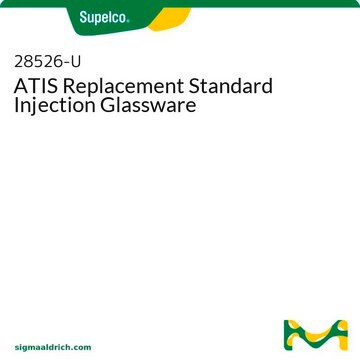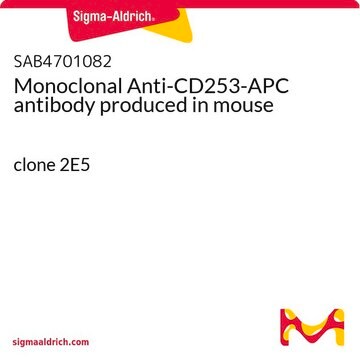Wszystkie zdjęcia(1)
Kluczowe dokumenty
29735-U
SLB®-1ms Capillary GC Column
L × I.D. 15 m × 0.32 mm, df 0.25 μm
Zaloguj sięWyświetlanie cen organizacyjnych i kontraktowych
About This Item
Kod UNSPSC:
41115710
NACRES:
SB.54
Polecane produkty
Materiały
fused silica
Poziom jakości
agency
meets requirements for USP G1, G2 and G9
Parametry
-60-340 °C temperature (isothermal)
-60-360 °C temperature (programmed)
Wartość beta
320
df
0.25 μm
metody
GC/MS: suitable
gas chromatography (GC): suitable
dł. × śr. wewn.
15 m × 0.32 mm
grupa aktywna macierzy
Bonded and crosslinked; poly(dimethyl siloxane) phase
Zastosowanie
petroleum
typ kolumny
capillary non-polar
Szukasz podobnych produktów? Odwiedź Przewodnik dotyczący porównywania produktów
Opis ogólny
Zastosowanie: Niepolarna faza dimetylowa zapewnia elucję w temperaturze wrzenia. Charakterystyka niskiego upustu, obojętność i trwałość sprawiają, że jest to kolumna wybierana do wielu zastosowań petrochemicznych lub wszędzie tam, gdzie wymagana jest kolumna niepolarna o niskim upuście.
Kod USP: Kolumna spełnia wymagania USP G1, G2 i G9.
Faza:
Kod USP: Kolumna spełnia wymagania USP G1, G2 i G9.
Faza:
- Związany i usieciowany
- Poli(dimetylosiloksan)
- -60 °C do 340 °C (izotermicznie) lub 360 °C (programowo)
Informacje prawne
SLB is a registered trademark of Merck KGaA, Darmstadt, Germany
Ta strona może zawierać tekst przetłumaczony maszynowo.
Wybierz jedną z najnowszych wersji:
Masz już ten produkt?
Dokumenty związane z niedawno zakupionymi produktami zostały zamieszczone w Bibliotece dokumentów.
Single giant vesicle rupture events reveal multiple mechanisms of glass-supported bilayer formation.
Chiho Hamai et al.
Biophysical journal, 92(6), 1988-1999 (2006-12-26)
The formation of supported lipid bilayers (SLBs) on glass from giant unilamellar vesicles (GUVs) was studied using fluorescence microscopy. We show that GUV rupture occurs by at least four mechanisms, including 1), spontaneous rupture of isolated GUVs yielding almost heart-shaped
Martin D Hürlimann et al.
Journal of colloid and interface science, 297(1), 303-311 (2005-11-23)
We present new NMR techniques to characterize food products that are based on the measurement of two-dimensional diffusion-T2 relaxation and T1-T2 relaxation distribution functions. These measurements can be performed in magnets of modest strength and low homogeneity and do not
Ryugo Tero et al.
Langmuir : the ACS journal of surfaces and colloids, 27(16), 9662-9665 (2011-07-19)
Hierarchic structure and anomalous diffusion on submicrometer scale were introduced into an artificial cell membrane, and the spatiotemporal dependence of lipid diffusion was visualized on nanostructured oxide surfaces. We observed the lipid diffusion in supported lipid bilayers (SLBs) on step-and-terrace
P Vahmani et al.
Lipids, 51(12), 1427-1433 (2016-11-18)
Human liver cells (HepG2) were cultured with individual trans (t) 18:1 including t6-, t12-, t13-, t14-, t15- and t16-18:1, and retention times of their Δ-9 desaturation products were determined using 100-m biscyanopropyl-polysiloxane and SLB-IL111 columns. Corresponding peaks were found in
Carla Ragonese et al.
Analytical chemistry, 83(20), 7947-7954 (2011-09-10)
The present research is focused on the evaluation, in terms of efficiency and polarity, of a recently introduced gas chromatography (GC) column, coated with a 1,12-di(tripropylphosphonium) dodecane bis(trifluoromethansulfonyl) amide ionic-liquid stationary phase (SLB-IL59) and its application to the analysis of
Nasz zespół naukowców ma doświadczenie we wszystkich obszarach badań, w tym w naukach przyrodniczych, materiałoznawstwie, syntezie chemicznej, chromatografii, analityce i wielu innych dziedzinach.
Skontaktuj się z zespołem ds. pomocy technicznej








